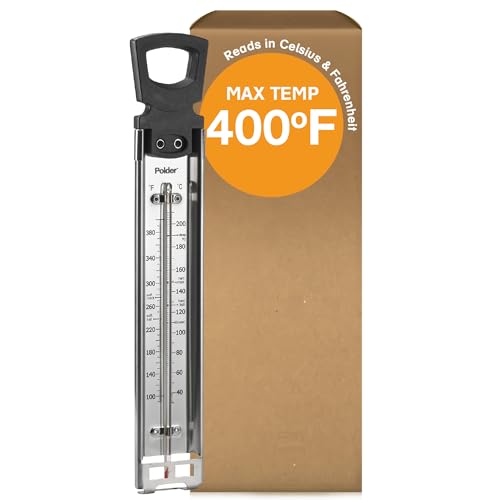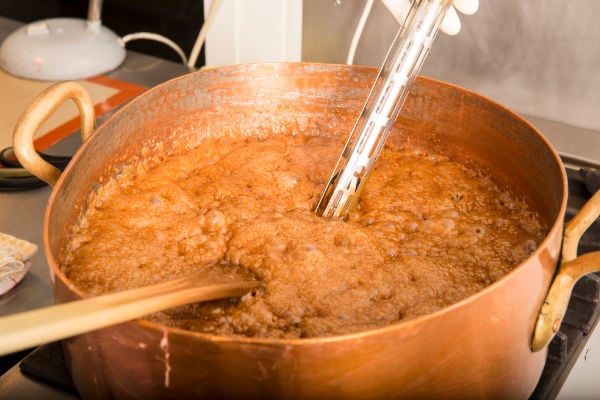After spending a total of two days researching the best candy thermometer, testing the shortlist, and then reaching out to our network of Facebook groups, we found the best candy thermometers for at-home use. As you'd expect, some models are better designed than others. We’ll look at the pros and cons of each brand later in this article.

The good news is that there’s more than one use for a candy thermometer, so it’s not a tool that will sit in the cupboard unused for months. Fudge, honeycomb, deep frying, taffy, jam, tempered chocolate, and even meat can all be cooked with precision thanks to this unassuming tool.
Table of Contents
Our Top Picks
Best budget candy thermometer: Taylor Candy Thermometer at Amazon
"This low-cost thermometer features a helpful clip and an easy-to-read scale."
Best overall option: Polder THM-515 at Amazon
"A feature-packed model without the hefty price tag attached."
Best premium choice: Lightbeam Digital Spatula Thermometer at Amazon
"A premium 2-in-1 tool with a unique design and many features."
Introduction
With many recipes, getting the temperature of the food exactly right isn’t a big deal. It certainly won’t make or break the dish. Candy making and most other recipes that involve heating sugar are different. It requires very precise temperature measurements. As the sugar solution is heated, it reaches milestones like the soft crack and hard crack stages. When recipes call for a solution to reach one of these stages, you need to get it right. That's where a candy thermometer comes into play. It’s designed to measure very high temperatures with high levels of accuracy.
Quick Fact: A candy thermometer can also be called a sugar thermometer, deep fryer thermometer, or jam thermometer.
The Best Candy Thermometers [2020]
1. Anpro DT-10 Candy Thermometer

The Anpro DT-10 is a budget digital thermometer that is made from quality stainless steel materials. The beauty of this product is that it offers multi-purpose usage. So, once you finish making candy, use it for roasting the perfectly cooked chicken, brisket, or any other cut of meat. With the Anpro, you can test the internal temperature of the protein.
If you’ve ever made candy, you’ll know that the liquid becomes hot—think molten lava hot. The Anpro has a decent-sized 4.5-inch prong, so you can keep your prized skin away from potential burns. Of course, a clip to attach to the saucepan would be preferable, and it would be an excellent upgrade for future models.
Analogue models can be a nightmare to read when you’re in the heat of cooking. Thankfully, this unit has a decent-sized, digital LCD screen—it’s a big bonus. When timing and temperature precision can make or break your recipe, it’s good to know you get accurate, easily visible readings.
Being a multi-purpose thermometer, it does have one drawback. It isn’t purpose-built for candy making, so you don’t get the visual cues of the stages of candy making: soft crack, hard crack, soft ball, hard ball, et cetera. If you prefer to see the various stages on a scale, then an analogue thermometer would be your best bet.
Keep in mind that the Anpro is not waterproofed, so you'll need to carefully wipe it with a damp cloth.
Pros
- Easy-to-read digital display makes checking temperature easy
- Unit automatically shuts off after 10 minutes to save battery power
- Quality stainless steel materials used
- Measures temperatures from -58°F to 572°F (-50°C to 300°C)
- Warranty is an impressive 24 months with fast response claims
- Safe to use thanks to a long probe
Cons
- Readings aren’t instant, there is some delay
- Need to hold with hand as there is no clip
- Not waterproof so need to carefully wash with a damp cloth
2. Polder THM-515 Candy Thermometer

The Polder THM-515 is made by a company that has built a solid reputation in the market for kitchen gadgets. This particular model is made from high-quality stainless steel, so rust won’t be a concern over time.
The temperature scale ranges from 90°F to 400°F (30°C to 200°C), and reading the temperature is a cinch thanks to a clear, easy-to-read analogue display. The Polder thermometer also includes helpful information, such as when the liquid has reached the “thread stage” or “hard crack stage.” Why would you need this? Let’s say you’re making honeycomb and you’re not following a recipe. If you know that honeycomb needs to reach the hard crack stage before being removed from the heat, you can simply wait for the mercury to rise up to the hard crack line on the thermometer. Easy!
When opening the Polder THM-515, the first thing you may notice is its size. It’s a large unit at 15” in length and weighs over 6oz (181 grams). Some may find it a little too large for their liking, especially if you work with small pots. The problem is that clipping it onto small pots isn’t possible. You’d need to hold it with your hand.
The insulated handle doesn’t retain any heat, which makes holding it pain-free and safe even after it’s been attached to the pan for 10 minutes.
The Polder is dishwasher-safe, but you’ll need a very long cycle to get it clean if you’re heating sugar. Once it cools on the thermometer, it’s incredibly difficult to wash off. The best option is to simply use a damp cloth and clean it immediately after use.
Pros
- Quality stainless steel construction
- Heat-resistant handle
- Helpful labels on the scale indicate the stages of heating sugar
- Able to calibrate
- Clip to attach to a large pot
Cons
- Difficult to attach if the pan is small
3. Taylor Precision Products Candy Thermometer

The Taylor Candy Thermometer is a good option if you’re looking for an affordable option. This is a simple tool but still effective at helping you make candy, pastry cream, fudge, taffy, chocolate tempering, deep-fried doughnuts, and much more.
This model includes a useful clip, so you don’t need to keep holding it over the pan to get a reading. The clip is adjustable, so you’ll find it suitable for most sized pots and pans.
Pros
- Established manufacturer with solid reputation
- Dishwasher safe
- Quality stainless steel materials
- Measures temperatures from 100°F to 400°F
- Displays candy-making stages from thread to hard crack
- Clip for attaching to pan
- Large 8” face with easy-to-read scale
Cons
- The numbers tend to wear off over time
4. Norpro Candy Thermometer

The Norpro Candy Thermometer is a stainless steel-built gadget that is simple yet effective. An adjustable clip allows the user to attach it to any-sized pot or pan, so there’s no need to worry about the tip touching the pan’s bottom.
The Norco candy thermometer is a basic design with few parts. This makes it super easy when it’s time to clean up. Simply pop it in some hot, soapy water to clean it.
Reading the temperature isn’t as easy as using a digital thermometer. The temperature increments are oddly spaced out, which isn’t ideal for reading if you’re in a hurry. The other analogue gauges on this list included the stages from thread to hard crack. This would be a helpful addition to this tool as well.
Pros
- Stainless steel construction
- Adjustable clip for attaching to the side of a pot
- Easy to clean
Cons
- Can’t be calibrated if the temperature is out
- Temperature increments are a little confusing to read
5. Lightbeam Digital Spatula Thermometer

If you’re looking for a premium candy thermometer that has all the bells and whistles, then this is the option for you. The Lightbeam Digital Spatula Thermometer is the ultimate in multipurpose gadgetry, ideal for the professional chef or at-home cook. Use this spatula to stir mixtures and take the temperature reading at the same time. This is brilliant for tempering chocolate where stirring is required.
For sugar heating, where you don’t stir the liquid, the spatula can be removed to reveal an impressive-looking probe. This can be used for candy making, as well as creams, sauces, and even meat.
The Lightbeam Digital Spatula Thermometer has a digital display providing readings between -58°F and 572°F. It is battery-powered, so there is no need for wires that get in the way.
Pros
- Accurate and quick temperature readings
- 2-in-1 spatula or probe options
- A sleek-looking tool that looks impressive
- Easy to clean, although not dishwasher safe
- Comfortable, ergonomic handle
- Perfect for inside use or grilling outside
Cons
- Difficult to change battery as the screws are very small

Features to Consider in a Thermometer
Type
Digital: Like a digital clock, the readings are displayed as numbers. The benefit of going digital is that you’ll get quick readings that are accurate. It’s also easier to read than an analogue scale, which takes a little longer to decipher. Another benefit of digital is that some units include an alarm to let you know once you’ve hit the right temperature.
Analogue: These are the old-school types of thermometers that have been around since their invention in 1714. As the mercury is heated, it rises up the scale. These gadgets are simple, have fewer complex parts in their design, and are often more affordable. They tend to take longer to give a reading than the digital option, as mercury is slow to rise. This may not be ideal if you’re tempering chocolate and need very precise measurements.
The scale display on an analogue model will sometimes have the benefit of showing the various stages of heating sugar. Some will consider this a handy feature to have.
Glass: These thermometers are analogue and usually have a clip so that you can attach them to the side of a saucepan. It’s important to check the length to make sure it’ll fit in your saucepan without hitting the bottom. This will give a false reading and should be avoided at all costs. Possibly the biggest downside to a glass unit is that it can easily be broken. When you’re rushing around in the kitchen, it’s quite easy to break the glass, as it isn’t overly thick. If you can find a brand that includes a protective case, that’s a great feature to have.
Metal: This is the type that has a probe that’s useful for measuring meat temperature as well as liquids. A major benefit of metal-constructed thermometers is that they are durable. No breakage in the heat of cooking!
Handheld vs clip-on
Heating sugar takes time. That’s why a clip-on thermometer is hugely beneficial. Simply attach it to the saucepan and start working on another task in the kitchen.
Durability
Metal will usually outlast glass over the long term. It’s almost impossible not to smash the glass ones if they are used frequently. Be sure to choose quality stainless steel that won’t rust in a few months.
Ease of cleaning
Most digital thermometers aren’t suited to regular washing or dishwashers because you can damage the components. This isn’t really a deal breaker, though. No matter what type you use, it’s best to wash the thermometer immediately after use with a damp cloth. Allowing liquid sugar to harden will make it really tough to clean.
Length
Check the length before investing in a thermometer. If you choose a clip-on model and it’s too long, it will touch the bottom of the pot. This will mess with the temperature reading, and your candy will disappoint.
How to Calibrate Your Thermometer
Occasionally, it’s well worth the effort to calibrate your thermometer. It’s like sharpening your knife set—it seems like a tedious chore, but the final result makes it all worthwhile.
Before you start, check that your thermometer has the option to be calibrated, as not all models can.
To calibrate, place the thermometer in boiling water and allow it to give you a reading. If the reading you get isn’t 212°F (100°C), then you know it’s out of calibration. Manually adjust to the correct temperature.
If your thermometer is giving a false reading and there is no calibration option, it's best to toss it out and replace it with a new model. It may cost money up front to buy a new one, but it’ll save you a lot in wasted ingredients from failed recipes.
FAQs
Thanks to its low moisture content, candy has a long life expectancy. To find out more, take a look at our article on how long you can expect candy to last.
An instant read thermometer, as the name suggests, gives a temperature reading quickly and can be digital or analogue. Some, but not all, of these thermometers can be used to make candy. You’ll need to check the specifications of the specific model to ensure it can record high readings over 450°F.
A candy thermometer should never touch the bottom of a pan, as it will give a false reading. Ideally, the tip of the thermometer should be ¼ of an inch from the bottom of the pan for the most accurate results.
A regular food thermometer is not suitable for making candy as its temperature range is too low. A candy thermometer is unique because it is capable of reading the very high temperatures needed when heating liquid sugar.
If you don’t have a candy thermometer, you can test the sugar liquid by scooping a small spoon of the liquid and dropping it into very cold water.
Reach in and feel the ball.
If it’s a soft, flexible ball, then you’ve reached the soft ball stage.
If the ball holds its shape, it’s reached the hard ball stage.
If the ball separates into hard, bendable threads, you’re at the soft crack stage.
If the ball separates into hard, brittle threads, the sugar has reached the hard crack stage.
Most meat thermometers aren’t designed to reach the high temperatures required in candy making.
Although candy thermometer models could be used in the oven, it’s best to use a purpose-built oven thermometer that’s designed to take the occasional knock and all parts can withstand the heat.
Final Words
If you’re looking to reward yourself with a premium candy thermometer, then the Lightbeam Digital Spatula Thermometer is hard to beat. It looks great, is built with quality materials, and has some excellent features. It’s incredibly helpful to be able to incorporate a thermometer into a spatula because that’s one less utensil you need to pull out of the cupboard (and wash).
For the best all-round candy thermometer, the Polder THM-515 is brilliant. It doesn’t have all the features that you get from a Lightbeam Digital Spatula Thermometer, but it does what it’s supposed to do well: measure high temperatures.
What’s your all-time favorite candy thermometer? Do you prefer analogue or digital better? What’s your all-time favorite cheese slicer? Perhaps you have a selection of tools that you pull out, depending on the occasion. Let us know in the comments below.

Leave a Reply